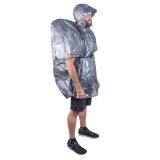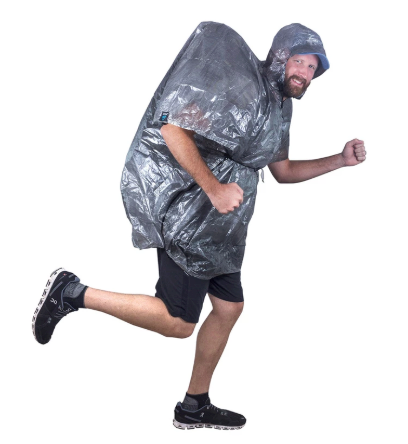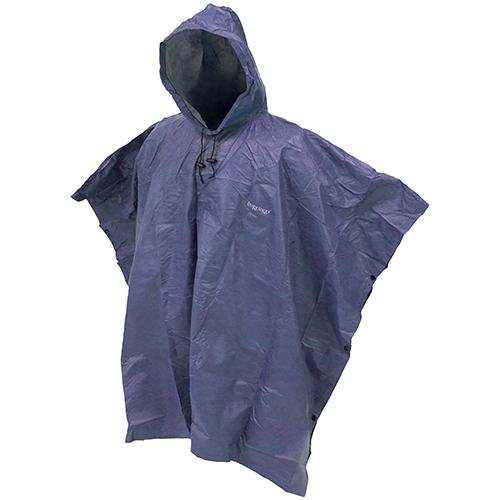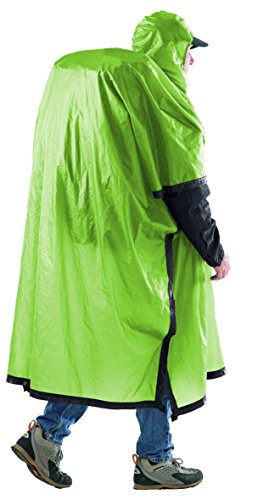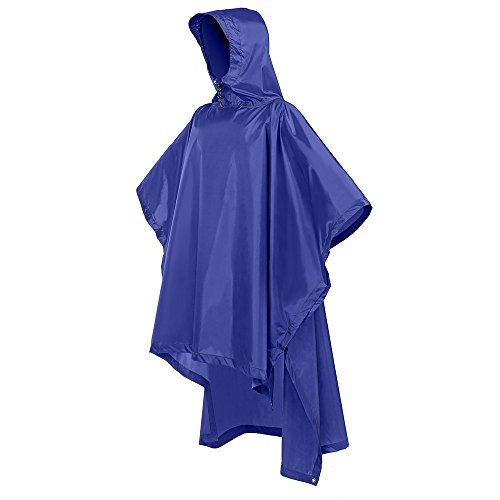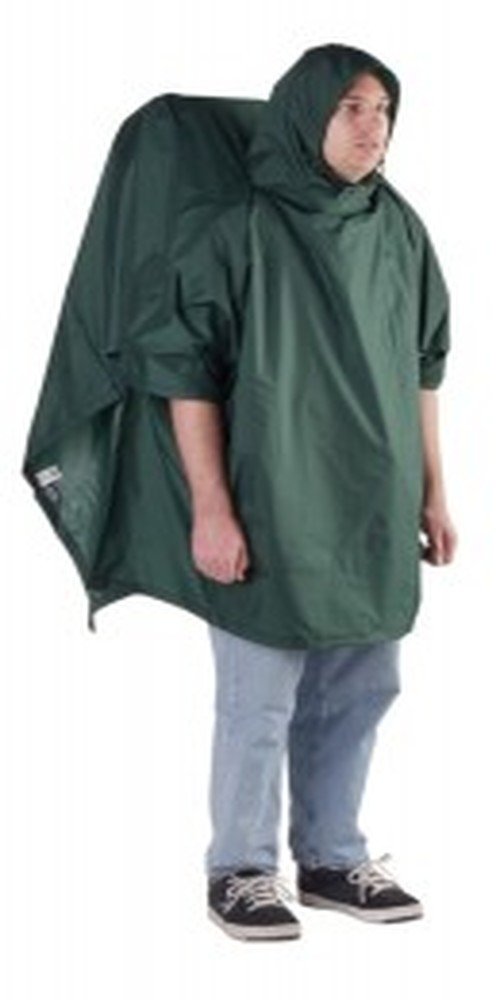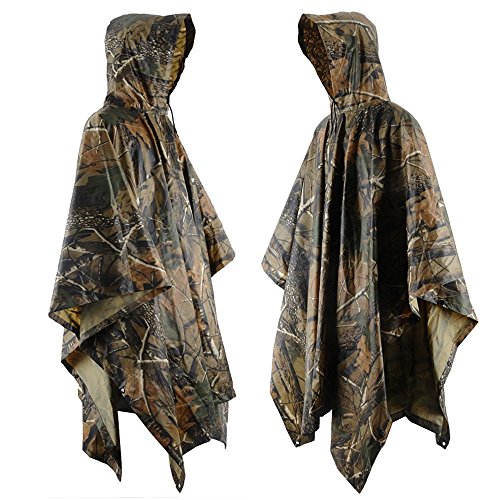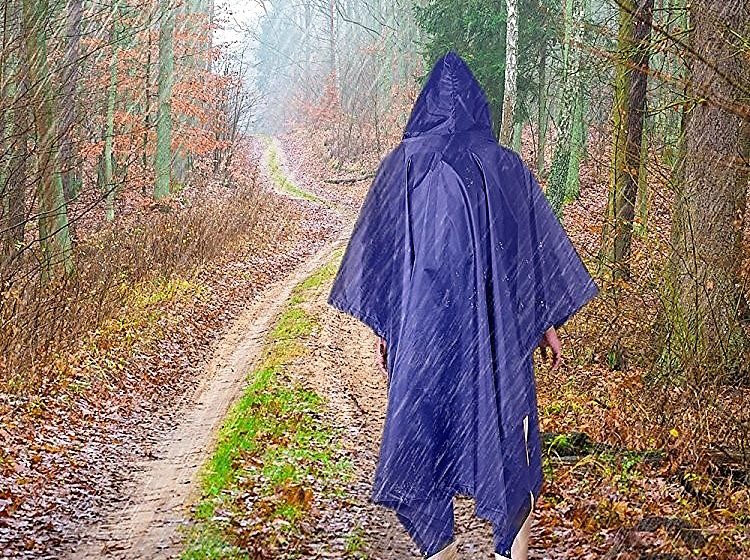
I’ve spent hundreds of nights on the trail guiding trips and I’ve used everything from plastic bags to waterproof ponchos for backpacking.
So I understand — better than most people — that choosing the best rain poncho for backpacking is a much more involved process than it might seem. Assuming you’ve already asked all the right questions and decided that a rain poncho is the correct option for you, there’s still much to decide before you buy.
More...
In this article, I’m going to guide you on how to choose the right waterproof clothing. In the process, I’ll share some tips and tricks while recommending a few options you can pick from to get started.
Don’t worry about ‘getting it right’ off the bat: most backpackers will own many waterproof coats over the years. I’ve gone through more than I can count since I started! Just remember that a big part of backpacking is always improving yourself, your knowledge, and your gear.
Comparison Table
Name | Price | Weight | Rating | Notes |
|---|---|---|---|---|
$$$ | 5 oz | ultra-lightweight waterproof poncho | ||
$$$ | 8.8 oz | Snaps down the sides | ||
$$$ | 8.15 oz | Easily converts from rainwear to a 2-person shelter | ||
$$$ | 8.6 oz | Thickened eyelets create enhanced durability | ||
$$$ | 0.79 lbs | Made from water-resistant, urethane-coated nylon taffeta with watertight bound-seam construction | ||
$$$ | 1.6 lbs | Made from 100% PVC Waterproof polyester Material | ||
$$$ | 9 oz | Made of 210T ripstop nylon fabric + PVC coating | ||
$$$ | 2.5 oz | Made from vacuum-metalized polyethylene Heatsheets, it reflects 90% of your body heat to help you stay warm. |
How to Choose the Best Backpacking Poncho for You
Aside from all the obvious technical details and jargon, there are some tips and tricks I can give you. That’s why this section is dedicated to technical and empirical knowledge!
Waterproof Materials
Let’s briefly go over some of the waterproof materials you can pick from. For backpacking ponchos these materials are usually limited to:
Sil-Poly and Sil-Nylon are both inexpensive and highly effective choices. They’re affordable because they’re simple fabrics. Nylon or polyester is saturated with silicone to create a durable, waterproof fabric. There’s little to know or worry about with these!
Silicone coatings are applied in the textile making process and create a uniform material. While there are silicone waterproof sprays available, they’re not a substitute for properly manufactured silnylon or silpoly.
Don’t get lost in the debate between silnylon or silpoly, either. They’re effectively the same material at the end of the day for the purposes of 99.9% of the backpacking community. Plus, with all the different weaves, deniers, and compositions of these fabrics there’s a near-endless number of variations used by different manufacturers, unsurprisingly, they all claim to be the “best”.
Breathable Laminates are what I call waterproof breathable fabrics. They’re made from a sandwich of (usually) nylon exteriors with a varying combination of underlying layers. These underlying layers can be made from many different fabrics and plastics that allow water vapor to pass outward, but remain waterproof from the outside in. Once dominated by Gore-Tex, the breathable market is now home to many great brands of breathable fabric.
There’s a ton of information out there about different waterproof breathable fabrics. Defining criteria include: how fast does water vapor pass through, how light is the fabric, how durable is the fabric, etc.
Suffice it to say that most in-house brands of breathable fabrics are as good, or sometimes better than, many name-brands. If you want to spend hours analyzing laboratory tests of breathable fabrics, the info is out there!
Cuben Fiber is a semi-magical material made from a sandwich of plastic mylar and dyneema fibers. If you want the lightest weight waterproof fabric available, this is it. Unfortunately, it will also cost you an arm and a leg!
Cuben fiber, or dyneema composite as it’s now called, was originally invented for sailboat racing. Because of the waterproof qualities and insanely lightweight it also makes great backpacking gear.
While dyneema composite is very strong in tension due to the dyneema fibers, it’s terribly weak to punctures. Additionally, many of the extremely thin dyneema composite fabrics are so delicate and lightweight that they don’t hold up well in terms of durability when compared to many conventional options.
There’s no doubt that in today’s market you can’t get any lighter-weight than cuben fiber gear. However, it requires some special attention and care and deep pockets!
PVC is used as a layering material as well as a standalone material. Some of the cheapest waterproof ponchos out there are made from just PVC. These plastic-y, rubbery ponchos are the cheap ones you find in the camping aisle of Walmart. That doesn’t make them bad, though! They work and can be easily repaired with duct tape. Plus, they’re cheap as hell!
PU Coated Nylon is also an affordable waterproof material. You get nylon fabric on the outside (fantastic durability and wear resistance) and waterproof polyurethane on the inside.
PU coated nylon is cheap to produce and many of the more famous waterproof garments have been made this way over the years (think: Marmot Precip). These garments tend to be a great all-around blend of value, function, durability, and performance.
Pro Tip: Look for pit-zips on PU coated garments as they can get uncomfortably clammy and sticky in humid weather.
To Poncho or Not to Poncho?
That is, in fact, the question of the hour. Ponchos, as you’re aware, are not the only waterproof option for backpacking garments. There are coats, umbrellas, and other options available. So why pick a backpacking poncho? Poncho advantages include:
Of course, ponchos get a bad rap for being geeky and silly looking. Fortunately, no one cares what you look like in the backcountry.
Backpacking magazines and action photos rarely feature a hiker rocking a rain poncho. All the sexy, fancy media surrounding hiking focuses on those super expensive fancy jackets by top brands like Mountain Hardwear, Patagonia, or Arc’Teryx. If your rain poncho doesn’t cost as much as a fancy jacket, it must not be good, right? Wrong.
I personally adore rain ponchos for the advantages listed above. But, they do have some drawbacks:
Ponchos are not really a good option for tasks that require tons of gear like climbing. Ponchos aren’t durable enough for activities like canyoneering which can abrade and abuse gear. Finally, ponchos make a poor choice (usually) for winter activities. They don’t close all the way and leave too much room for biting winds to drive into your layers underneath.
When You Don’t Need a Poncho
Many summertime hikers in temperate climates where the weather is largely predictable will choose not to hike with rain gear. I’d recommend you at least take something to block the wind and rain in an emergency even during warm summer hiking.
However, I think it merits mentioning that you may not always need to carry or use rain gear. Every time the skies open up and drench you does not, necessarily, merit wearing rain gear.
For instance, during 90+ degree summer days on the Appalachian Trail, you might just choose to keep on hiking. The rain is refreshing, enjoyable, and warm enough to be safe. Putting on rain gear in these warm conditions would only serve to soak you in sweat, anyway.
Going Cheap
One of the biggest advantages of ponchos is how affordable they are. Because there are no zippers, no fitted cuffs, and nothing fancy they can be made quickly and inexpensively. That ends up getting passed on to us in the form of ultra-cheap rain gear.
If I could go back and advise my younger self on what rain gear to get when I had no money, I would have gone this route. Even if you have the cash, there’s something to be said about spending smart money.
I would urge you to make sure that you differentiate between inexpensive and cheap. There are poorly made ponchos out there for sure. But even if they rip you can patch them easily, or replace them at the next stop with ease.
Rain ponchos, as well as keeping the costs of your gear inexpensive, are great options for any backpacker. In fact, it may, in part, be a sign of skill to recognize when more expensive gear just isn’t needed.
Multi-Use Ponchos
Ponchos tend to be a favorite of two groups: beginners and ultralight backpackers. While this needn't be true, it seems the norm. For this reason, many high-end ponchos are made to serve more than one purpose.
As a major tenant of backpacking, any gear that can serve more than one purpose, should. In this spirit a poncho that can serve double duty is both lighter than the two constituent pieces, and a better value.
Common multi-use ponchos include:
Ponchos that are made with enough space to cover the pack can be useful if you like waterproof pack covers. Everyone has their own system for waterproofing the pack, so it’s up to you if this is helpful or not.
Ponchos that can be used as a tarp or shelter seem to have limited use to me. While they’re sometimes used by extreme ultralight backpackers I find them to be hamstrung.
Having to take off your rain gear in order to build your shelter leaves you exposed to the elements and soaked by the time you get into your shelter. Not to mention poncho shelters are barely big enough to fit inside, let along protect you from rain splash over.
While I’m a big lover of tarps for backpacking shelters, poncho tarps just don’t make the cut for me, personally.
Ponchos that can serve as a ground sheet, however, may make a bit more sense. That is, of course, as long as you don’t have to get out of your shelter in the middle of the night when it’s still raining and your poncho is still trapped under your gear…
Before investing in a multi-use poncho be sure to think critically about how, exactly, you’ll use it to meet your needs. We all have different systems, habits, and routines on the trail. Multi-use ponchos will work for some, and not for others.
Poncho Repairs and Maintenance
Once you’ve hit the trail with your poncho, it will inevitably need some love along the way. One day you’ll catch it on a branch and tear a hole in it. Or you’ll leave it soaked in your bag for one day too long and pull it out smelling like swamp.
Taking care of your poncho doesn’t need to be hard but you have to keep a few things in mind.
Poncho Repairs
For any silicone-based or nylon fabric repairs such as those on PU coated nylon, silnylon, or silpoly you can use silicone seam sealer and a small patch of nylon or polyester for repairs.
Use a silicone seam sealer like the Gear Aid brand. Apply a circle of silicone sealer around the hole. Cut a patch of nylon or polyester big enough to cover the hole, plus a half inch. Then simply sandwich the patch over the hole.
Use some books to hold everything together for a day or two while it dries.
To keep your books or pressing objects from getting messy use wax paper to keep silicone off of things.
In the field you can do the same repair as long as you carry a little silicone seam sealer and some patches.
Cuben fiber can’t be patched with silicone. It won’t stick.
Instead, the easiest thing to do is buy and carry a few patches of cuben fiber repair tape. Clean and dry the area to be repaired, tape it up, and you’re done!
It’s insanely easy and makes a long-lasting strong repair. Just make sure to carry some with you!
Frogg Toggs ponchos are made from a composite textile that’s famously easy for being repaired using just duct tape. It’s that simple.
PVC or vinyl rain gear can also be patched with duct tape pretty easily as long as it’s clean and dry. Alternately, you can buy and use special PVC cement and patches which provide a more robust repair.
Poncho Maintenance
The best maintenance is prevention for ponchos. Once they’re wet, let them air out to dry. Stuffing them in the bottom of your pack when they’re still wet will probably cause a mildew problem particularly in hot climates. Mildew can destroy waterproof fabrics.
If your poncho gets nasty from stink, sweat, or swamp it’s best to follow the care instructions on the garment.
Many waterproof fabrics are particularly fragile so avoid washing machines if possible. Waterproof/breathable laminate garments and silnylon garments tend to be much more robust, however, so you can usually wash these according to instructions.
For cuben, PU coated, vinyl, and PVC you’ll want to just give them a soapy water bath in a bucket. Hang them to dry and you’re done.
Waterproof Restoration
There’s a big market for wash-in or spray on DWR coatings. Durable water repellent coatings are synthetic additives that adhere to the fabric of a garment and help it shed water.
These are only necessary on breathable garments. PVC, PU coated, cuben, vinyl, and silnylon or silpoly won’t benefit from these additives. All of these garments are inherently waterproof and, if they lose their waterproofness they need to be repaired or replaced as the waterproof agent has failed or is failing.
Waterproof breathable garments, on the other hand, can wet out over time. Nylon or polyester make up the outermost layer of these garments and, once the DWR coating wears off, this layer can wet out. Once the outer layer of these garments is saturated, water vapor can no longer pass through.
This is why it’s important to restore the DWR coating on waterproof/breathable garments. Without it, they’re no longer breathable and can’t do their job.
Seam Seal Repair
A waterproof garment is only as good as the seam seal. If the seam tape or seam seal on your poncho fails (if it has seams at all) then you’ll get wet.
Note that cuben fiber or dyneema seams are “welded” and the seal can’t come apart unless it’s a manufacturing defect. If your cuben fiber seams begin to fail the garment may need replacing.
To repair seam sealing the best and easiest method is silicone seam sealer.
Use mineral spirits to dilute silicone seam sealer. Stretch the seam taut and brush on the diluted seam sealer so it can penetrate into the seam. Allow it to dry, flip the garment over, and repeat on the other side.
Here’s a great video on seam sealing you can use as a guide.
Best Waterproof Ponchos of 2020
In my search for the best backpacking ponchos available today, nothing was able to hold a candle to the Zpacks cuben poncho. This longstanding winner has long been the top pick on my personal list and, after much debate, it wins the top pick on my list for others.
This ultralight waterproof poncho is made from the expensive and hyper lightweight material cuben fiber. Cuben is made from a sandwich of waterproof mylar and Dyneema fibers. Both Mylar and Dyneema are incredibly strong in tension. However, the mylar is susceptible to puncture from piercing objects.
Once you know the limits of your gear you’ll be able to enjoy hitting the trail with a poncho like this. At just 5.1 ounces it’s lighter than just about anything else on the market. Plus, it’s meant to be used as a ground sheet. Zpacks made this poncho specifically to serve double use as both a poncho and a groundsheet.
Because it’s made from 1.0 oz/sqyd cuben fiber it’s one of the most robust and durable Dyneema composite fabrics out there. However, you can still ruin it if you set it up improperly as a groundsheet. Be sure the ground is free of sharp debris like jagged rocks, sharp roots, or pine needles before setting it up.
Unlike most waterproof fabrics, cuben fiber doesn’t need to be stitched. Instead, it is heat bonded or welded together. This seam construction is both more durable than stitching and truly waterproof. No seam sealing necessary. That means the seams will remain 100% waterproof for the life of the poncho without maintenance at all!
There’s also 1-year warranty against flaws in workmanship on all Zpacks products. So if it falls apart in just 6 months, you can return it without any worries. That’s insanely unlikely, however, as Zpacks is one of the most respected ultralight backpacking brands today.
Frogg Toggs gear is a topic hotly debated in the backpacking community. Many disdain the products for their low price and low “durability”. Others, however, worship Frogg Toggs as the only rain gear worth owning on the trail.
These waterproof ponchos are made with a papery texture that’s fully waterproof. That’s thanks to the polypropylene material used to create them. This synthetic material is also weldable which means it can be heat sealed together for a strong, waterproof seam.
One reason this poncho made the cut over some other choices is because of the fully recyclable material. If it gets destroyed, just toss it in the recycle bin instead of the landfill. Nice!
Adjustable good and snaps along both sides of the garment make this about as adjustable as a poncho can get. Since you can fully open the poncho, you could feasibly use it as a ground sheet or tarp. However, I distrust the durability of the material for these applications.
That brings us back to the durability factor. Frogg Toggs gear is not going to stand up to bushwhacking. It will tear on thorns and branches. However, for on-trail use, it’s just fine. In fact, the material is well known for being reparable with just duct tape.
This backpacking poncho actually stands as my personal favorite. So, why didn’t it make the top of our list? Because the price is quite a bit higher than other silicone based ponchos, but it’s not as light as the Zpacks cuben poncho. But is the value worth the price as a happy middle ground? Let’s find out.
Unlike other ponchos, the Ultra-Sil is made from a durable and tough silicone fabric. This fabric is then double stitched and seam sealed. That means you’ll have a waterproof, durable poncho that’s very unlikely to rip.
At just 8.15 ounces this poncho is lightweight! Even more so when you consider that it can be used as a shelter on the trail.
The poncho is designed to be able to be opened up and tied out to be used as a tarp shelter. Many hikers, including myself, rely almost exclusively on tarp shelters for their many advantages. Plus when you combine your rain gear and your shelter into one piece of gear you lighten and shrink your pack!
Of course, how well this tarp performs as a primary shelter remains to be seen. It would probably be most advisable to use it, instead, as a backup or emergency only shelter.
There’s not much fancy about this hiking poncho, but it gets the job done. With 210T polyester waterproof fabric, it’s actually quite beefy and durable which I like. Many of the ponchos available today, and those on our list, are lightweight but lack real durability.
Instead, this rugged poncho rocks reinforced grommet holes in all four corners for staking down or using as an emergency tarp. I’m not going to recommend that you use it exclusively as a footprint or tarp because that will probably shorten its life. However, it’s up to you. If you can replace part of your kit with a durable poncho like this, the extra weight might be worth it.
Like the other ponchos on our list, I’ve tried to find only the ones with enough room to accommodate a backpack underneath. These ponchos are longer on the backside than the front. Which means that when you drape it over your pack it ends up being a roughly equal length.
The one feature I dislike on this poncho is that there are no arm adjustments. The sides of the poncho are solid and feature no buttons or zips. That means it will be hard to use your arms freely without exposing yourself to the rain. Sad.
I have to admit that I like this poncho for its simplicity. There’s no real attempt to be a multi-purpose item here, just a reliable waterproof rain poncho with room for a backpack.
In fact, it proved hard during my research for this article to find reliable rain ponchos that also have room for a pack. If you were to just go buy the first poncho you see from the shelf at Walmart, chances are good that it won’t be designed to accommodate a backpack.
The Backpacker Poncho by Outdoor Products makes sure there’s room for a large pack underneath! At almost 13 ounces it’s not an “ultralight” poncho but it definitely beats many waterproof rain jackets for weight. Plus for those of you who like to have a pack cover, it takes away the need to carry a standalone item for that.
I like that the snaps along the side leave room for your arms to hang free without having to lift up the poncho. Some of the other ponchos on our list have features to be used as a tarp or groundsheet but lack the snaps along the side. That seems like a big oversight in my opinion. For that reason, I think this poncho actually nudges ahead of some others on our list.
You’ll have to decide which features are the most important to you. While you don’t get the “can be used as a tarp” feature on this poncho, you do get adjustable arm snaps and an adjustable hood. Arguably both of those are more important…
Like most of the ponchos on our list, this one attempts to do it all. Unlike the Terra and the Sea to Summit, I wouldn’t trust this one as a tarp or ground cloth. But that doesn’t mean it can’t make a fine poncho for hiking and backpacking. Not everything has to be a multi-tool.
One feature unique to this poncho is the neckline zipper. While this adds both bulk and weight it does offer some flexibility that we haven’t seen in other ponchos.
I do like the use of ripstop polyester. Though I will mention that while it is fully seam sealed some users complain about the reliability of the waterproofing. Whether or not this is due to the fabric, the seam sealing, or quality control is hard to say.
One major advantage of this poncho is the inclusion of grommet holes on the corners. Again, I wouldn’t recommend relying on any poncho solely for use as a shelter. But many survivalists and hikers alike praise multi-use gear. For that reason, it may be an advantage which appeals to you.
This is going to be overall more durable than the Frogg Toggs. However, I prefer the Frogg Toggs or Sea to Summit for the reliability of manufacturing and quality.
If it’s value you want, then Anyoo can deliver. It’s another all-arounder trying to bridge the gap of tarp, shelter, poncho. At this price, though, I think it’s pretty safe to at least give it a try.
Made from PVC coated ripstop nylon, this poncho comes in exactly a bazillion colors. Be careful which model you select, however, as not all of them include the tarp feature if that’s important to you.
Seams are taped for watertightness, but I wouldn’t expect to get more than a few seasons use out of them like most PVC coated products. I like the large brim on the hood of the poncho, a feature sorely lacking on many ponchos.
It includes drawstrings and snaps for fitting while wearing as well as grommets for staking out as a tarp.
This one makes the cut on our list because it takes things in a different direction. If you’re looking for a lightweight, low-bulk emergency poncho for backup this might be the choice.
In the backpacking world, I’ve long felt that “survival” gear is overrated with a few exceptions. Heat reflective blankets and ponchos like this are one of those exceptions. Keeping water off and heat in is crucial to any emergency situation and this one is so light and small you can carry it for years until you need it.
Reflecting 90% of your body heat makes this poncho a sweet choice for emergency situations. Of course, it’s also made to keep out the elements. Because it’s water proof it’s also windproof (like all other waterproof garments) which cancels out any convective heat loss.
Now, don’t be fooled. It’s not durable enough to be your primary rain gear. However, it fills a need as a backup or emergency item and earns a place on this list.
Conclusion
When it comes down to it, you really need to go back and ask yourself what your goals are. Which features your rain poncho has will depend on how you want to use it.
Some survivalists and ultralight hikers may want a multi-function poncho. Others are happy to use the poncho solely as rain gear. There are ponchos on our list that fit well with both descriptions.
For those wanting only rain protection, the inexpensive and lightweight Frogg Toggs poncho makes a solid contender. If you’re an ultralight purist or want the finest quality lightweight waterproof rain poncho, you won’t find a better one than the Zpacks poncho!
Of course, budget plays a major role in gear decisions. Think about how much you’re willing to spend before you step into the arena to avoid blowing your budget for the month!

